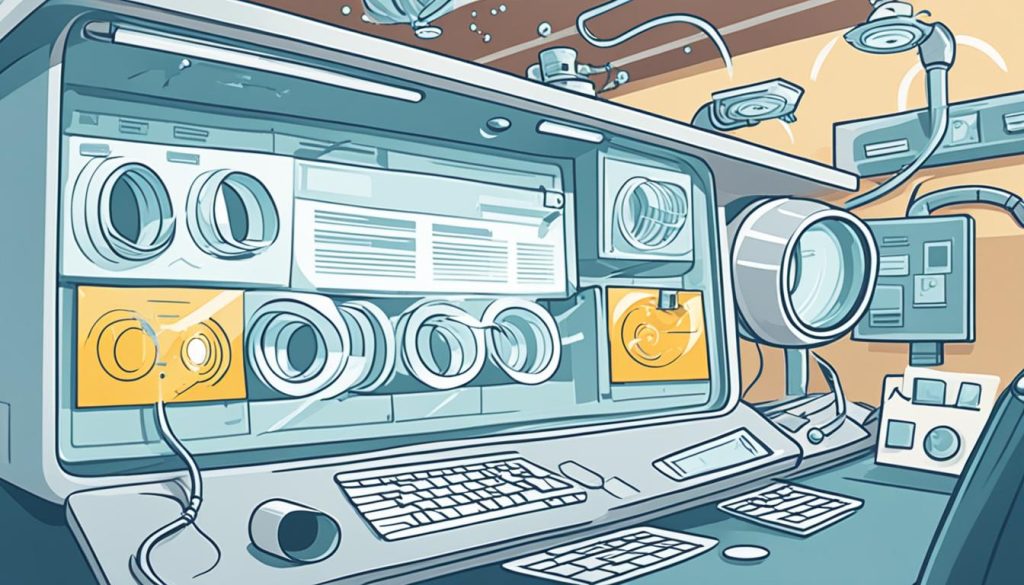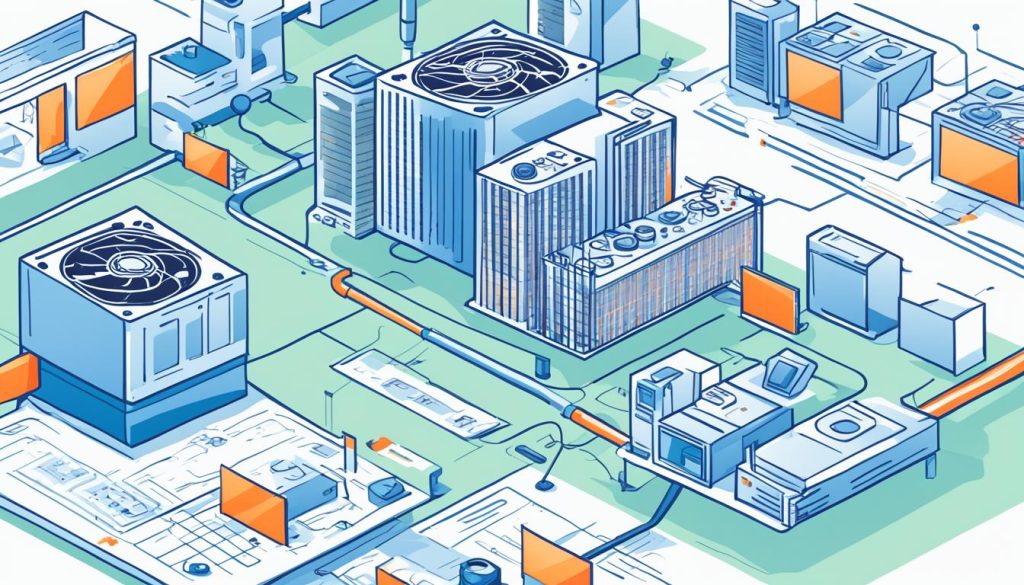To keep up with safety rules, use safety protocol tracking in air duct dispatch software. These tools help you watch and follow safety rules. This makes sure your HVAC business follows the rules.
Air duct dispatch software is key to staying compliant. It lets you track safety rules in real-time. It also automates paperwork and makes reports to show you follow the rules.
Using these tools makes following rules easier, lowers risks, and keeps your workers and customers safe. Tracking safety protocols makes sure every job is done right. This cuts down on accidents and rule-breaking.
Adding safety management systems to your dispatch software gives you a single place to handle compliance. This helps you keep up with new rules in the HVAC field. You can change your safety plans as needed.
Understanding Regulatory Compliance in the HVAC Industry
The HVAC industry has many rules to keep things safe, efficient, and high quality. These rules touch every part of air duct dispatch work. It’s key to know and follow these rules to keep your business running well and to stay on the right side of the law.
Key Regulations Affecting Air Duct Dispatch
Many groups set rules for air duct safety. The American Society of Heating, Refrigerating and Air-Conditioning Engineers (ASHRAE) makes sure systems are energy-efficient and the air is clean. The Occupational Safety and Health Administration (OSHA) looks after safety at work. The National Fire Protection Association (NFPA) sets rules for fire safety in HVAC systems.
Importance of Compliance for Business Operations
Following these rules is more than just following the law. It’s key to running a successful HVAC business. It keeps your workers safe, makes systems work better, and keeps customers trusting you. Checking you’re following the rules helps spot problems early, saving time and money later.
Consequences of Non-Compliance
If you don’t follow HVAC rules, the risks are big. You could have accidents, get hurt, or damage property. You might face big fines, legal trouble, and harm to your business’s reputation. In the worst cases, you could lose your business license and have to close down.
| Compliance Area | Benefits | Risks of Non-Compliance |
|---|---|---|
| Safety Standards | Reduced accidents, lower insurance costs | Injuries, lawsuits, increased liability |
| Energy Efficiency | Lower operating costs, improved customer satisfaction | Higher energy bills, environmental penalties |
| Air Quality | Healthier indoor environments, fewer complaints | Health issues, potential legal action from clients |
The Role of Safety Protocol Tracking in Compliance
Safety protocol tracking is key for keeping up with HVAC industry rules. You must have strong safety steps and check if people follow them. This way, you can spot dangers, stop accidents, and keep getting better at safety.
Good safety steps mean making clear checklists and rules for your techs. These cover how to handle equipment and deal with dangerous stuff. By sticking to and tracking these steps, your HVAC company shows it cares about following the rules and lowers the chance of breaking them.
Keeping up with compliance needs constant watchfulness and hard work. You should often look over safety records, check sites, and go over incident reports to find ways to get better. This way, you can stop big accidents and avoid big fines.
| Safety Protocol Element | Compliance Benefit | Risk Mitigation Strategy |
|---|---|---|
| Equipment Checklists | Ensures proper tool maintenance | Reduces equipment-related accidents |
| Personal Protective Equipment (PPE) Guidelines | Meets OSHA requirements | Minimizes worker injuries |
| Hazardous Material Handling Procedures | Aligns with environmental regulations | Prevents chemical spills and exposure |
| Incident Reporting System | Facilitates timely regulatory notifications | Enables swift corrective actions |
Having a strong system for reporting incidents is key for staying compliant. This system lets techs easily record and share any safety worries or close calls. By looking into this data, you can spot patterns and act before big problems happen.
Essential Features of Air Duct Dispatch Software for Compliance
Air duct dispatch software is key for following the rules. It helps HVAC companies work better and keep up with safety rules. Let’s look at the main parts that make this software vital for following the rules.
Real-time Tracking Capabilities
Real-time monitoring changes the game for air duct dispatch. It lets managers see what technicians are doing right away. This means they can make sure safety rules are being followed.
You can see where technicians are, what jobs they’re on, and what tools they’re using. This makes things run smoother and helps follow the rules better.
Automated Documentation and Reporting
Automated reporting makes keeping records easy. It lets you make detailed reports on safety checks, upkeep, and audits. This makes it simpler to show you’re following the rules during checks.
Integration with Industry Standards
It’s important to keep up with the latest rules. Your dispatch software should easily use the newest HVAC standards and best practices. This keeps your work in line with changing rules.
| Feature | Benefit | Impact on Compliance |
|---|---|---|
| Real-time Monitoring | Instant visibility of technician activities | Ensures adherence to safety protocols |
| Automated Reporting | Effortless documentation generation | Simplifies compliance audits |
| Industry Standard Integration | Up-to-date regulatory information | Maintains ongoing compliance |
With these key features, your air duct dispatch software is a strong tool for following the rules. It makes things run smoother, keeps things safer, and helps your business keep up with industry standards.
Implementing Safety Management Systems in Dispatch Software
Adding safety management systems to your air duct dispatch software is key. It keeps you in line with the law and boosts safety. These systems spot hazards, track safety, and push for ongoing improvement in your HVAC business.
To start, add risk assessment tools to your software. These let you check for dangers before sending out your team. Spotting risks early means you can stop them before they start.
Then, set up incident reporting in your software. This lets your team report any safety issues or close calls fast. Reporting in real-time helps you fix problems quickly and stop them from happening again.
Don’t forget about corrective action plans. Your software should help make and track these plans. This makes sure problems get fixed right.
| Safety Management Feature | Benefits |
|---|---|
| Risk Assessment Tools | Proactive hazard identification and mitigation |
| Incident Reporting Mechanisms | Quick response to safety issues and prevention of future occurrences |
| Corrective Action Plans | Systematic resolution of identified safety concerns |
With these features in your dispatch software, you get a full safety management system. It helps you follow the law and builds a safety-first culture in your company.
Maintain Regulatory Compliance with Safety Protocol Tracking
Safety protocols are key to following the rules in the HVAC industry. They keep your workers safe and help your business run smoothly. Let’s see how to keep up with these rules.
Establishing Comprehensive Safety Protocols
Make a safety manual that covers everything about air duct dispatch. It should have rules for handling equipment, spotting hazards, and what to do in an emergency. Make sure to check and update these rules often to keep up with new laws and standards.
Utilizing Software Tools for Tracking and Monitoring
Use software to help manage your safety better. These tools let you keep an eye on safety performance, track employee training, and make reports on compliance. Pick software that works well with your current systems for easy data sharing and up-to-date information.
Regular Audits and Updates
Do safety checks often to find any weak spots in your safety plans. Use what you learn to make your safety steps better and fix any compliance problems. Keep up with changes in the industry and add new safety info to your plans quickly. This way, you can stay compliant over time and avoid fines.
- Schedule quarterly internal audits
- Perform annual third-party assessments
- Review and update safety protocols bi-annually
- Implement corrective actions based on audit results
By focusing on these areas, you can create a strong safety plan. This plan will protect your business and workers and meet the rules.
Risk Assessment and Incident Reporting in Air Duct Dispatch
Risk assessment and incident reporting are key to keeping air duct dispatch safe. By using strong risk assessment methods, you can spot dangers before they lead to accidents. Good incident reporting helps document and analyze safety events, leading to better practices.

To find hazards, look closely at your workplace. Check equipment, work processes, and the environment. Make a checklist to review each part of your operations carefully.
After finding hazards, use risk assessment to see how likely and severe they could be. This helps focus on the most urgent risks. Common ways to do this include:
- Job Safety Analysis (JSA)
- Failure Mode and Effects Analysis (FMEA)
- Hazard and Operability Study (HAZOP)
Set up incident reporting that makes it easy for workers to share safety worries. This could be a digital system linked to your dispatch software. Make sure everyone feels safe reporting issues without fear.
It’s important to regularly analyze safety data for ongoing improvement. Look at incident reports, near-misses, and risk assessments to spot trends and areas to improve. Use this info to update safety rules and training.
By doing thorough risk assessment, reporting incidents quickly, and analyzing safety data, you can make your work environment safer. This keeps you in line with regulations in air duct dispatch.
Training and Educating Technicians on Compliance Protocols
It’s key to have good HVAC safety training to follow the rules in the air duct dispatch field. By making detailed training plans, you make sure your technicians can deal with dangers and stick to safety rules.
Developing Effective Training Programs
Starting with strong training programs is key to following the rules. These programs should cover all HVAC safety rules, like:
- How to use personal protective gear right
- Safe ways to handle refrigerants and other dangerous stuff
- How to be safe with electricity
- How to prevent falls
- What to do in an emergency
Continuous Learning and Skill Development
The HVAC field is always changing, so are its safety rules. Offer ongoing chances for your technicians to learn new safety practices and rules. This includes:
- Regular refresher courses
- Workshops on new tech and safety gear
- Online modules for learning at your own pace
- Going to industry events and seminars
Measuring and Improving Compliance Adherence
To see if your training works, you need to check and get better at following the rules. Use strategies like:
- Regular safety checks and inspections
- Tracking safety incidents and close calls
- Testing skills in real situations
- Getting feedback from technicians on how well the training works
By focusing on these areas, you can make safety and following the rules a big part of your company. This lowers risks and keeps your technicians and customers safe.
| Training Component | Frequency | Method | Performance Indicator |
|---|---|---|---|
| Basic Safety Protocols | Annually | Classroom + Hands-on | Written Test + Practical Assessment |
| Equipment-specific Training | Bi-annually | On-site Demonstration | Skill Demonstration |
| Regulatory Updates | Quarterly | Online Modules | Quiz Scores |
| Emergency Response | Monthly Drills | Simulations | Response Time + Accuracy |
Leveraging Data Analytics for Continuous Improvement
Data analytics helps HVAC businesses improve safety and follow the rules better. It uses safety data analysis and performance metrics to find important insights. Let’s see how to use these tools to keep getting better.

Safety data analysis helps spot patterns in your work. By looking at incident reports and how equipment works, you can see what needs work. This way, you can stop accidents before they happen and follow the rules better.
Performance metrics show how well your company is doing. Keep an eye on things like how fast you respond, how well you finish jobs, and what customers think. This info helps set goals for getting better, pushing your team to be the best.
Predictive maintenance changes the game in HVAC. By looking at equipment data, you can guess when things might break. This cuts down on downtime and makes things safer by fixing problems early.
| Data Analytics Tool | Benefits | Impact on Compliance |
|---|---|---|
| Safety Data Analysis | Identifies risk patterns | Reduces incidents and violations |
| Performance Metrics | Measures operational efficiency | Improves overall compliance adherence |
| Predictive Maintenance | Prevents equipment failures | Enhances safety and reduces risks |
With data-driven insights, following the rules gets easier. Use analytics to keep track of what the rules say, when they’re due, and how you’re doing. This helps you use your resources well and stay on top of compliance issues.
Adding these data analytics tools to your air duct dispatch software makes a strong system for always getting better. Regular checks and actions based on these insights will push your business towards safer and more compliant standards.
Conclusion
Following safety rules is key in the HVAC industry. It’s what keeps your business running smoothly. By using strong safety systems and technology, you can make sure your air duct work meets the law.
Keeping your team safe is very important. It makes your work better and protects your company’s good name. Following the best HVAC practices, like training and checking up on things, makes you stand out. It shows you’re all about doing great work.
Always looking to get better is the heart of staying compliant. Using data and encouraging learning helps you keep up with new rules and trends. This way, you stay on the right side of the law and bring new ideas to your work.
Being compliant is more than just avoiding fines. It’s about making your HVAC business safer, more efficient, and successful. By focusing on safety and using technology, you’re building a strong future for your company. You’re also setting new high standards for the industry.





0 Comments